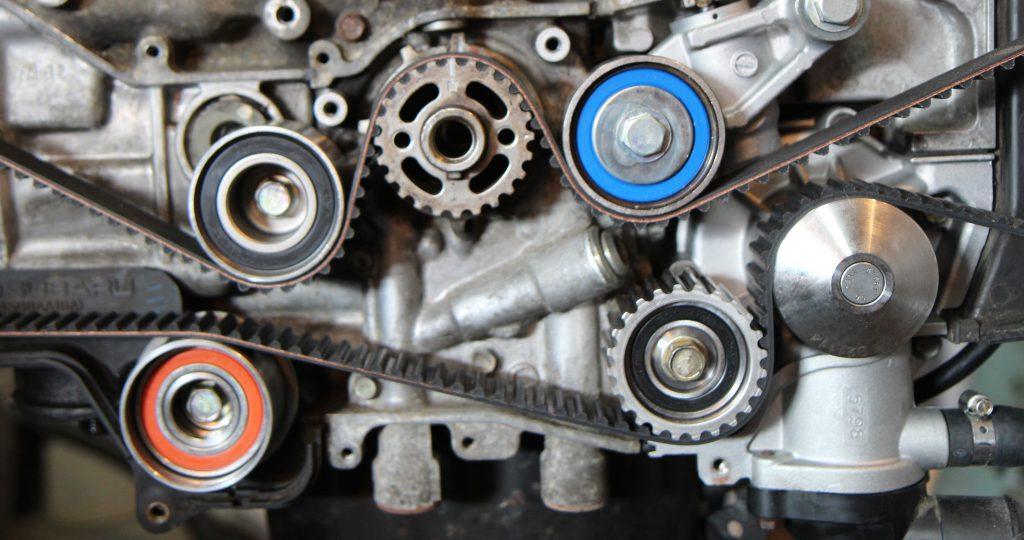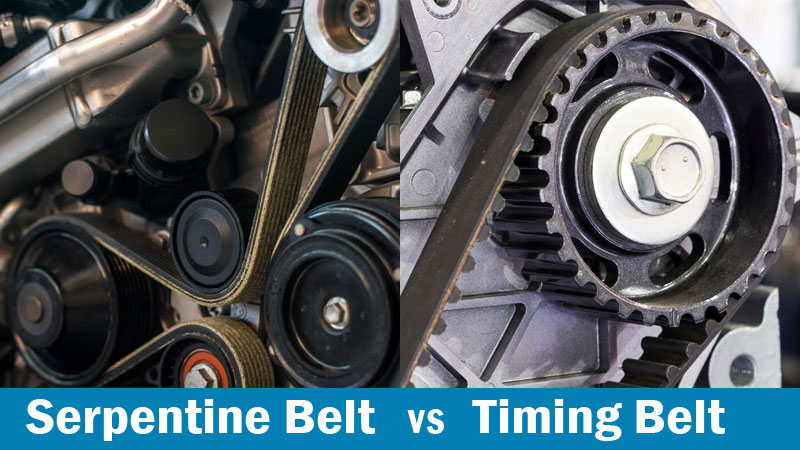Serpentine belt and timing belt are two different belts in a car engine. Serpentine belt drives various engine components while the timing belt synchronizes the engine’s camshaft and crankshaft.
The engine is the heart of a car that delivers power to the wheels by converting fuel and air into motion. To perform optimally, an engine requires various components to work together. Two of these components are the serpentine belt and timing belt.
The serpentine belt is responsible for driving components like the alternator, power steering pump, and water pump. On the other hand, the timing belt synchronizes the engine’s camshaft and crankshaft, controlling the flow of air and fuel into the engine. While both belts are crucial for an engine to function, they have different purposes and mechanisms. This article will examine and explain the differences between the serpentine and timing belt, helping car owners understand their cars’ complicated workings and how to maintain them properly.

Credit: carfromjapan.com
What Is A Serpentine Belt?
A serpentine belt, also known as a drive belt, is a critical component in a car’s engine. It powers the alternator, air conditioning, power steering, and other systems. Unlike the traditional timing belt, a serpentine belt is not related to engine timing.
Its primary function is to drive various systems in the engine, ensuring they operate smoothly. A serpentine belt can last longer than traditional belts, but it can be costly to replace. When choosing a serpentine belt, factors such as car make and model, driving style, and climate should be considered.
Opting for high-quality belts is recommended for better performance and longer life.
What Is A Timing Belt?
A timing belt is a crucial component in most car engines. It synchronizes the rotation of the crankshaft and the camshaft, allowing proper operation of engine valves. Without a timing belt, the engine can’t run smoothly or at all. Compared to a serpentine belt, timing belts tend to be more efficient and last longer.
However, they also require more maintenance and can be costly to replace. Before choosing a timing belt for your car, consider factors such as cost, durability, and the warranty offered by the manufacturer. Choose wisely to ensure your car’s engine stays in top shape.
Serpentine Belt Vs Timing Belt: Differences And Similarities
Serpentine belt vs timing belt: differences and similarities serpentine belts and timing belts play critical roles in a car’s engine. While serpentine belts drive accessories like power steering pumps, timing belts operate the camshaft, synchronizing engine compartments. Maintenance and replacement are essential for these belts’ functionality and longevity.
The cost of timing belts is higher than serpentine belts. Timing belts require replacement every 60,000 to 100,000 miles, while serpentine belts last around 50,000 miles. To avoid untimely altering of belts or malfunctions, it is important to monitor their functioning and inspect them, especially after 50,000 miles.
Check for cracks, missing teeth, and wear and tear on belts. Comparing serpentine and timing belts in terms of functionality, durability, cost, and maintenance is essential for optimal engine performance. Understanding their differences can help save time and money.
Choosing The Right Belt For Your Car
Choosing the right belt for your car is crucial for vehicle performance. When deciding between a serpentine belt and a timing belt, several factors should be considered. Serpentine belts are easier to maintain, while timing belts ensure optimal engine performance.
Pros and cons of different belt types should be weighed carefully, taking into account fuel efficiency, cost, and longevity. As for maintenance, the frequency of replacement for each type is different. For serpentine belts, regular checking for wear and tear is advisable, while timing belts should be replaced at a specific mileage interval.
Follow the manufacturer’s recommendations to keep your car running smoothly. Remember to choose the belt that’s right for your specific car model and make.
Frequently Asked Questions For Serpentine Belt Vs Timing Belt
What Is A Serpentine Belt And How Does It Work?
A serpentine belt is a long, continuous belt that runs through several pulleys to power the engine’s accessory systems such as the air conditioning, power steering, and alternator. It works by transmitting power from the engine’s crankshaft to the different pulleys that drive the accessory systems.
What Is A Timing Belt And How Does It Work?
A timing belt is a non-slipping rubber belt that keeps the engine’s valve and piston movement synchronized. It synchronizes the rotation of the crankshaft and the camshaft, which ensures the opening and closing of the engine’s valves at the right time to maintain optimal engine performance.
What Is The Difference Between A Serpentine Belt And A Timing Belt?
The difference between a serpentine belt and a timing belt is the purpose they serve in the engine. The serpentine belt powers and drives accessory systems such as the air conditioning, power steering, and alternator. The timing belt, on the other hand, synchronizes the movement of the camshaft and the crankshaft to ensure optimal engine performance.
How Often Should I Replace My Serpentine Or Timing Belt?
Serpentine belts should be replaced around 60,000 to 100,000 miles, depending on the manufacturer’s recommendations. Timing belts usually need to be replaced between 50,000 to 100,000 miles as well or as per the manufacturer’s recommendation. It’s essential to get regular inspections to ensure the belt is in good condition.
What Are The Signs Of A Failing Serpentine Or Timing Belt?
Signs of a failing serpentine belt include squeaking sound, visible wear and tear, and accessories like the power steering system and air conditioning failing. Signs of a failing timing belt include ticking noise from the engine, engine misfire, low oil pressure, and even engine failure.
It’s crucial to get both belts checked regularly to avoid any potential accidents.
Conclusion
After closely examining the features, pros, and cons of both the serpentine belt and timing belt, it is safe to say that each serves a unique purpose. While both are responsible for transmitting power from the engine, the serpentine belt is primarily used for several accessory functions, while the timing belt controls the internal engine’s valves.
It is crucial to maintain and replace these belts at regular intervals to prevent any potential damage to the engine and ensure optimal performance. Consider factors such as your vehicle’s make and model and the type of driving you do when deciding which belt to use.
Always seek professional advice if you are unsure about which belt to install. So, now that you know their differences, make an informed decision to choose the right belt for your vehicle and enjoy a smooth driving experience.

